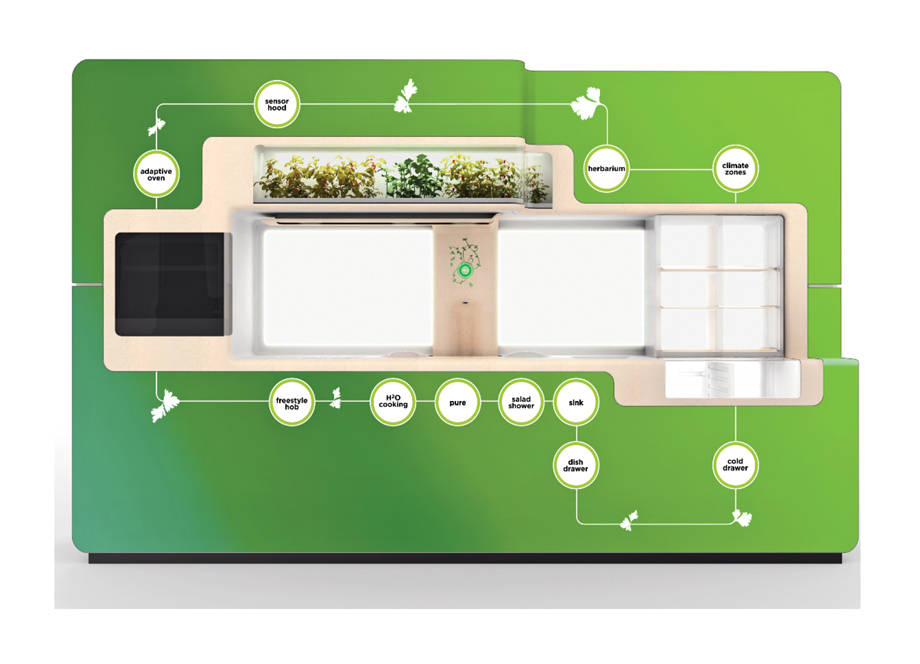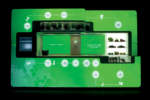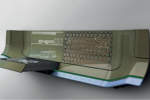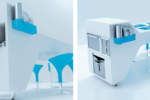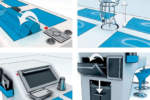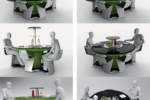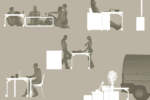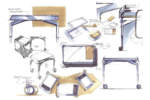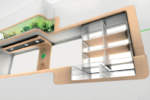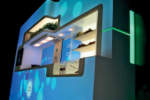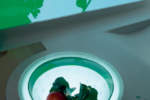“There is no love sincerer than the love of food”. (G.B. Shaw)
Relishing food implies an intense, high-level cultural experience: sensing that a natural, primitive substance can be magically transformed into the most exquisite delicacy, changes the everyday action of nourishment into the ultimate multi-sensorial experience that can only come from the esoteric act of cooking.
Whether eating hastily in the most popular take-away, or savouring recipes handed down from your grandmother accompanied by noisy company sharing a common yet sacred domestic pleasure, or tasting the gastronomic inventions of gourmet professionals, at the primordial approach of taste and smell, the tactile, visual, acoustic, sensorial and aesthetic increase in importance for the consumer. Whether the choice of what to eat represents an individual journey, or in some cases limit, typical of socio-culturally circumscribable geographical areas (such as America), the ceremony of conviviality, especially when preceded by preparing food together, and the desire to share that food with known and unknown people, becomes an act of love and seduction.
We plan not only how to consume, eat or taste food, but also how to cook, offer and present it. Preparing food is increasingly a sacred act through which we recount explorations, real or imagined, describing sensorial trajectories that aim to capture different worlds.
What emerges, therefore, is an attitude that puts culinary creation on a par with artistic and aesthetic endeavours, with forays directed into design and architecture. Add to all of this rhythm, choreography, costume and scenery (in a kind of renaissance remake) that celebrate the theatrical show that is eating.
So the kitchen becomes intuitive, founded in emotion. It ceases to be purely functional, an operative cell that calls for punctuality and functionality that is all about food. Instead the kitchen is transformed into a sculptural presence trying to camouflage the furnishings and objects within the domestic space. It slowly becomes the house’s centre of gravity requiring the biggest investment of domestic living space construction (in the United States the kitchen sector recently made over 170 billion dollars, five times more that the film industry). In other words, the kitchen has become a fashion object. But where is the kitchen of the future heading? What new relationships will emerge between kitchen appliances, the domestic environment and a usage that is increasingly orientated towards regaining possession of a culinary model for everyday life that rediscovers ritual steeped in ephemeral pleasures?
If we consider current research in the sector, what immediately comes to mind is the growing use of IT in all household appliances dedicated to the conservation and preparation of food.
In the hopes of making the living environment more comfortable, starting with working life, computers, management programmes and touch screens increasingly replace new consumers’ culinary skills. They remove the protagonist (the cook) from the scene or, better still, transform him or her into an orchestral conductor who, albeit inadvertently and without direct contact (see the Internet-connected system Screenfridge by Rex Electrolux), is able to manage roles and processes that once beat to the rhythm of the organisational and creative wisdom of a friendly gourmet cook. Biotechnology, nanotechnology, high-performance materials, multi-task and multimedia systems, ecology management, to name only a few, can – when suitably balanced and arranged – open new frontiers in the hi-tech cooking sector. They offer solutions that reduce user effort and amplify expressive potential in terms of new multi-sensory and aesthetic qualities of food.
The kitchen then becomes the fulcrum of the house, uniting entertainment, communication and utility. Computerised systems allow household appliances and multimedia equipment (radio, TV, Internet, etc.) to be managed via a network. At the same time they increase the perception of free time on the part of the person managing them. There are new formulas for more mobile, younger marketplaces: products that, on the one hand, are more expensive; but on the other are much more agile and protected, like Fevzi Karaman’s Transformer System, Marcello Zuffo’s Adaptable Kitchen, Lee Balin’s Kitchen Tree and Petr Kubik’s multifunctional table. All these design projects use an OLED touch screen to manage appliances, while software enables remote management of numerous integrated functions from the ease of a shared palm telephone. But ecology is where we find true innovation.
The drive to ecology, which constantly aims to provide products with a perfect chromosomal make up, isn’t limited to applying technology to minimise the costs of design, production, use and dimension; this is the real battle ground in a mature, saturated market in which producer and consumer agree on indispensable common rules. An appliance’s energy efficiency rating has become an increasingly important identity card. Consumers are aware that a shift in rating can mean much higher costs over the lifespan of an appliance. They have finally got used to paying attention to this aspect of their purchase. ‘Green Kitchen Design’, for example, is a philosophy that some companies and designers are developing to create a kind of “gastronomic ecology”, where eco-sustainability is amplified thanks to the use of new technologies. Designs by Alessi and Valcucine anticipate the arrival of soft and sinuous forms that hide technological equipment, respect the environment and safeguard the serenity of mankind.
Mustafa Emre Olur has created Alight, a kitchen with an integrated water filtration system that repeatedly reuses the same water. Nilay Shah proposes a kitchen for Veneta Cucine without a fridge and with containers made of wood and biodegradable plastic. An Antoine Lebrun kitchen for Fagor Brandt contains a small domestic garden that opens-out on the work surface, producing fresh air and filtering odours, thanks to technology developed originally for the aerospace industry. In all these designs and in many others in development, the kitchen escapes the logic of disorder and smells contained in a small environment and is on show. Household appliances lose their camouflaged, laminated shells and assume a sought-after role between form and function; plasma monitors and natural materials significantly enrich an already complex space. And the inhabitant rediscovers the kitchen as a place of permanence and passion.
There is one contradiction: between the spectacular technological services being offered on the market, and the worrying shortage of free time needed to cultivate the pleasures of preparing and tasting healthy delicacies, in a sitopic (from the ancient Greek sitos – food and topos – place) version of society, that is “a world shaped by food”. (Carolyn Steel) “Food increasingly takes on the guise of rhetoric when it comes to arguments that stray from attempts to create relationship and varied exhibitionisms”. (Stefano Casciani)
Yet, if the experience of food is the meeting of cultures and rituals expressed through consuming, eating or tasting, they also correspond to just as many moments of spiritual appropriation in the world. These powers could be harnessed to give a better shape to our lives.
multifunctional table
petr kubik 2006
Project by the Czech designer Petr Kubik presented to 2006 edition Design Lab, international competition announced annually by Electrolux, dedicated to students of design to obtain innovative ideas for future appliances.
A revolutionary compact appliance that emphasizes on convenience, energy saving and ergonomical usage. It is a multifunctional dining table integrated with a refrigerator and small kitchen appliances catering for up to five table guests. Dining at the table is a complex, well thoughtout activity that takes into aspect individual needs of every family, including access to internet. The part of the table used to refrigerate food is divided into two separate sections with a total volume capacity of 203 litres.This appliance saves on energy consumption, thanks to the innovation behind the food selection process as well as method for opening the refrigeration unit. The elegant & futuristic appearance is supported by the use of expressive colours in combination with a black glass and stainless steel accessories.
brandt aion
antoine lebrun 2007
The futuristic kitchen designed by Antoine Lebrun in partnership with Fagor Brandt, French company leader in the production of luxury appliances, is a multifunctional project combining technologies taken from aerospace industry.
The aim of this project is to highlight technological and social trends of tomorrow. These trends which are already visible today, could rule our lives in the next decade.
What would our life look like in 10 years? Growth of the population, centralization in cities, smaller living places, higher energy costs, water and air pollution, uncertain future. In such a context, new radical solutions could appear, renewing with nature and providing more comfort to users. Thanks to plants developed in the first place by the aerospace industry, this appliance will allow us to improve our quality of life. When cooking, the plants act as a filtering hood. Furthermore, they provide a renewable supply of clean water and vegetable soap. When it’s time to clean up, simply place the dirty dishes in the sink, close the hood, and the all natural clean cycle begins. This way, Aion offers to the user the basis for a healthier and more pleasant everyday life.
coox
antoine lebrun 2008
Antoine Lebrun’s cooktop on wheels is one of nine finalists in the Electrolux Design Lab 2008 competition. In this edition young industrial design students were invited to create appliance concepts for the internet generation.
Coox is a simple appliance which allows each user to cook in accordance with his own lifestyle. This flexible cooking table follows you in your flat, and allows you to cook at your desk when you work, near to your couch if you want to chill, or with your friends around a coffee table. Thanks to this product, the user doesn’t have to break his current activity to cook and eat. You can also stay connected to people when you have guests instead of cooking alone in the kitchen. The wheels allow you to easily move this product from a room to another one. Finally you have the possibility to adjust the height of the appliance in order to create an extension of your desk, coffee table or dinner table. A single design with a wide range of possibilities.
greenkitchen
whirlpool 2009
Whirlpool Europe presents a revolutionary vision of the future kitchen that will reduce the cost of the bill by 70%. The concept provides energy savings by optimizing the use of heat and water and making appliances have a dialogue in new ways.
At first sight Greenkitchen appears to be entirely similar to a ‘traditional’ kitchen, but the eco-integrated technology at the foundation of the concept makes it notably different, allowing it to recuperate up to 60% of the water and heat produced by kitchen appliances, so that it can be used to fuel others. In fact it uses the heat produced by the compressor in the fridge to produce hot water for the dishwasher. When you let the cold water run so the hot water comes through, the clean cold water is collected in a special container and, once treated with an antibacterial solution, can be used for the dishwasher, to water plants, or to clean the house.


